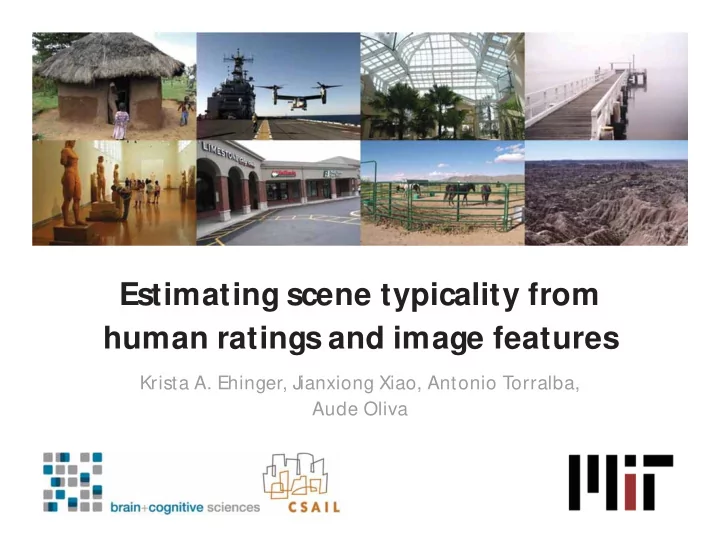

Estimating � scene � typicality � from � human � ratings � and � image � features Krista � A. � Ehinger, � Jianxiong Xiao, � Antonio � T orralba, � Aude Oliva
“chair”
“ kitchen”
• Are � there � “ typical” � examples � of � scene � categories? • Do � more � typical � examples � contain � more � of � the � visual � features � relevant � for � scene � categorization?
SUN � Database : � 899 � scene � categories, � 130,519 � images Xiao, � Hays, � Ehinger, � Oliva, � & � T orralba (2010)
Scene � Understanding � (SUN) � database Scenes: Not scenes: baseball_field equator warehouse golden_gate_bridge theater outdoors opera_house forest forest – evergreen forest – deciduous
Rating � scene � typicality • 706 � categories • 124,901 � images � (22 � – 2360 � images/category) • 935 � people � contributed � ratings � through � Amazon’s � M echanical � Turk � service
Rating � scene � typicality Category � images 20 � images � per � trial . � . � .
Rating � scene � typicality Category � images 20 � images � per � trial . � . � .
Rating � scene � typicality Category � images 20 � images � per � trial . � . � . . � . � . 77,331 � trials, � each � image � appeared � 12 � 15 � times
Rating � scene � typicality Category � images 20 � images � per � trial 14 � appearances 3 � “ best” 0 � “ worst” 12 � appearances 1 � “ best” 1 � “ worst” . � . � . . � . � . . � . � . 77,331 � trials, � each � image � appeared � 12 � 15 � times
Typicality � score “ best” � votes � – k(“worst” � votes) Typicality � = � k � = � 0.9 Number � of � appearances 0.67 -0.52 Voted � a � “ best ” � Voted � a � “ worst ” � exemplar � on � 8 � out � of � exemplar � on � 7 � out � of � 12 � appearances 12 � appearances
Examples M ost � typical � beaches M ost � typical � bedrooms
Examples Least � typical � beaches Least � typical � bedrooms
Rating � scene � typicality Category � images 20 � images � per � trial 14 � appearances 3 � “ best” 0 � “ worst” 12 � appearances 1 � “ best” 1 � “ worst” . � . � . . � . � . . � . � . Simulation: � Computer � randomly � selected � images
Typicality � scores: � Experiment � vs. � simulation
boardwalk M ost � typical Average closet M ost � typical Average
• Are � there � “ typical” � examples � of � scene � categories? – Y es, � there � is � a � range � of � typicality � in � scene � categories
• Are � there � “ typical” � examples � of � scene � categories? – Y es, � there � is � a � range � of � typicality � in � scene � categories • Do � more � typical � examples � contain � more � of � the � visual � features � relevant � for � scene � categorization?
Training Image � features “ beach” . . . . . . T est Are � more � typical � images � classified � more � accurately?
M achine � vision � classifier One � vs. � all � SVM � classifier � trained � • Feature � histograms � on � 50 � random � images � in � each � (color, � edges, � category, � tested � on � 50 � images texture � features) • GIST � descriptor • SIFT � descriptor • HOG � (histograms � of � oriented � gradients) • SSIM � (self � similarity) • Geometric � classes Felzenszwalb, � Girshick, � M cAllester, � & � Ramanan (2010); � Hoiem, � Efros, � & � Herbert � (2007); � Lazebnik, � Schmid, � & � Ponce (2006); � Oliva � & � Torralba � (2001); � Renninger � & � M alik � (2004); � Shechtman & � Irani (2007)
Classification � performance Humans = 68% correct Classifier = 38% correct Chance = 0.25% correct
Scene � classification � vs. � scene � typicality Average classifier performance = 38% Chance = 0.25%
Classification � confidence � vs. � scene � typicality
• Are � there � “ typical” � examples � of � scene � categories? – Y es, � there � is � a � range � of � typicality � in � scene � categories • Do � more � typical � examples � contain � more � of � the � visual � features � relevant � for � scene � categorization? – Y es, � more � typical � scenes � are � classified � more � accurately
Thank � you! Antonio � T Jianxiong Xiao orralba Aude Oliva This � work � is � funded � by � NSF � CAREER � award � (0546262), � NSF � grants � (0705677 � and � 1016862), � and � a � NEI � grant � (EY02484) � to � A.O; � NSF � CAREER � award � (0747120) � to � A.T; � and � Google � research � awards � to � A.O � and � A.T .
Recommend
More recommend